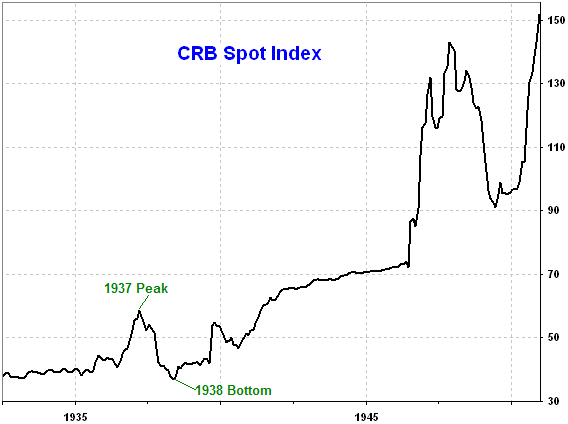Long-term outlook for commodities
Steve Saville
email: sas888_hk@yahoo.com
Nov 4, 2008
Below is an extract from a commentary originally posted at www.speculative-investor.com on 2nd November, 2008.
In a number of respects, not least being the magnitude of the decline, the closest historical parallel to the equity bear market of 2007-2008 is the equity bear market of 1937-1938. Interestingly, there was also a very sharp downturn in commodity prices during 1937-1938. Even more interestingly, the 1937-1938 commodity plunge proved to be the first major correction in a secular commodity bull market that lasted until the early 1950s.
The commodity bull market we are referring to is identified on the following long-term chart of the CRB Index. The chart hasn't been updated since 2007, but that doesn't matter because we are primarily concerned with what happened during the second quarter of the past century.

The next chart zooms in on our period of interest: the commodity bull market that extended from the early-1930s through to the early-1950s.

Thanks to Nick Laird of www.sharelynx.com for providing the above charts.
The long-term upward trend in commodity prices that began during 1933-1935 was largely a response to the inflationary policies of the F.D. Roosevelt Administration. To be more specific, the upward reversal in the long-term commodity trend was a reaction to Roosevelt's devaluation of the dollar relative to gold and to various government spending schemes introduced in an effort to boost economic activity. These policies led to strong economic growth during 1935-1937 and to a vigorous rebound in commodity prices, but because the economy's strength was based on artificial stimulus rather than increased real savings it didn't prove to be sustainable. Instead, the boom came to an abrupt end in early 1937 and all the economic 'progress' that had been made over the preceding 4 years was quickly obliterated. Consequently, by 1938 commodity prices were back to their 1932-1933 lows. In reality, no real economic progress had been made during 1933-1937. The government, via its massive spending, had only managed to create the ILLUSION of prosperity.
Believing that an even bigger artificial stimulus was the answer to the economic malaise of 1938, Roosevelt then embarked on a spending program that would be so grand as to make the fiscal and monetary recklessness of 1933-1937 look prudent by comparison. Fortunately (from Roosevelt's perspective), the wars in Europe and Asia provided the ideal justification for such a gargantuan spending binge.
One goal of the supercharged inflationary policies put into effect during the late-1930s was the elevation of prices, and this goal was achieved despite the constraints imposed by the semi gold standard of the time. The huge 10-year rally in the CRB Index from its 1938 bottom is evidence of this.
In summary, monetary inflation during the early-to-mid 1930s led to an economic boom and a commodity-price rally that quickly unraveled during 1937-1938, prompting the government of the day to implement spending schemes that would lead to vastly greater monetary inflation and a much bigger rally in commodity prices beginning in 1938.
There are obvious parallels between the 1930s and the current decade. In particular, monetary inflation during the early-to-mid 2000s led to an economic boom and a commodity-price rally that quickly unraveled during 2007-2008, prompting the current government to implement spending schemes that should ultimately lead to vastly greater monetary inflation. The deflationists argue that commodity prices will decline for years to come because credit contraction will counteract the effects of the profligate monetary and fiscal policies currently being put in place, but our view is that if the Treasury and the Fed were able to depreciate the dollar while the currency was still officially linked to gold then they will certainly be able to do so under today's system. As a result, we expect that commodity prices will bottom-out within the coming 12 months and then embark on another 5-10 year inflation-fueled rally.
The current decade's commodity story is illustrated by the following monthly chart of the Continuous Commodity Index (CCI). There was a lot more monetary inflation over the first 8 years of this decade than over the first 8 years of the 1930s, and, as a result, the commodity markets achieved much greater nominal gains during the 2002-2008 rally than during the 1933-1937 rally. For the same reason it is unlikely that the current downturn will retrace all, or even most, of the preceding gains. Rather, we suspect that the CCI's ultimate correction low will not be far from its October-2008 low.

Steve Saville
 email: sas888_hk@yahoo.com email: sas888_hk@yahoo.com
Hong Kong Regular financial market forecasts and analyses are provided at our web site:
http://www.speculative-investor.com/new/index.html. We aren't offering a free trial subscription at this time, but free samples of our work (excerpts from our regular commentaries) can be viewed at: http://tsi-blog.com
Copyright ©2002-2019 speculative-investor.com All Rights Reserved. Saville Archives
321gold Ltd

|



